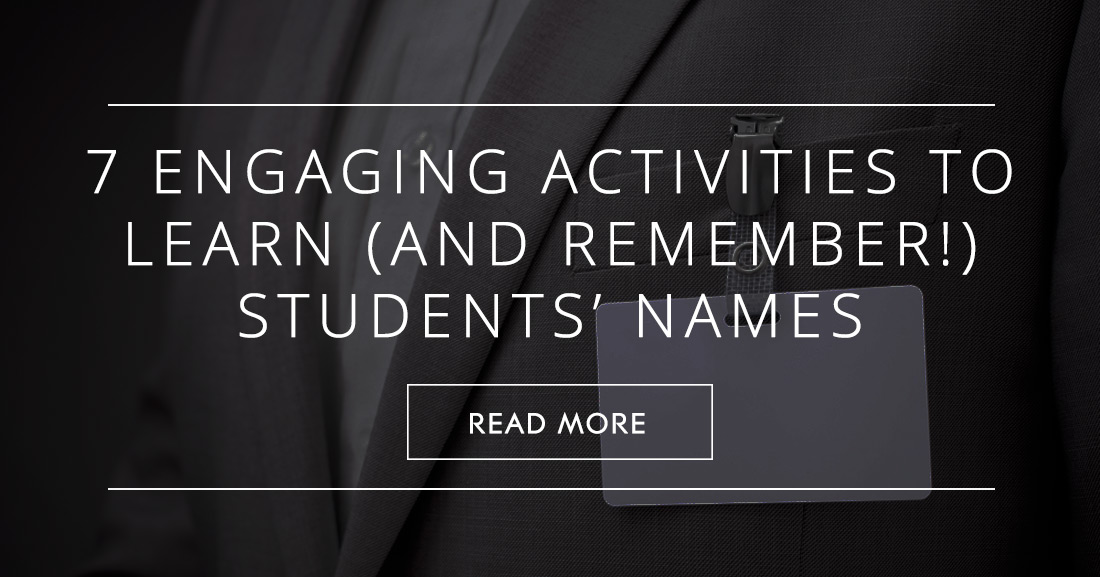7 Teacher Tested Tricks for Remembering Student Names


But the most important thing for students to learn right away is who their classmates are. Also, from a teacher’s perspective, it can be challenging to learn students’ names right away and keep them straight, especially for those of us with lots of classes. There is no better way to make students feel comfortable in their learning environment than by knowing that everyone knows their name. Here are some activities that will not only help break the ice but help you and your students learn and remember everyone’s names!

The most traditional way to keep names straight is give students name tags. With this option, it puts a little less stress on your memory and gives you some time to get used to your students. There are some ways to vary this idea of name tags though to keep it fresh and fun. One way is to make name tents for the desks that can be collected and redistributed daily. Change up the placement of the name tents to mix up students’ place in the classroom, randomly shuffle them to create new pairs or groupings of students, or take them home to help you review your students’ names. Another idea is to give them to one or two students each day or several times a class so they can review their classmates’ names. Alternatively, you can have students create nametags for other students in the class each day to help them review.
Put students’ names on the board or on signs around the room where everyone can see them and be reminded constantly. Also, you could have students make posters creatively using everyone’s name in the class and then display the posters so they’re always visible.
This one works like a charm every time. Have students sit in a circle and go first to give an example for what you’re looking for. I like to do this as the first activity of class, so I say my name, where I’m from, and my favorite English word. Then, the next student says his name, where he’s from, and his favorite English word followed by my information. The third student must then say his information, the second student’s information, and my information, and so on until the lucky last student attempts to do everyone in the room. Encourage your students that it’s not as hard as it sounds! As long as they listen and pay attention, they will be able to remember everyone’s name. You can do variations of this activity throughout the week as well, such as an adjective beginning with the same letter as their name, the first student says an item from the grocery store starting with A, the second student an item starting with B, etc...
Use each students’ name every time they speak in class. If you have forgotten their name for a moment, ask someone else in the class to provide that students’ name; not only will this give students more practice reviewing names, but you will be able to save a little face and no one will know you didn’t remember a name!
With your students, engage their creative side and have them make posters with anagrams of their names. You can have students do this for themselves or for another student (if you trust them to be nice!) Have them think of a word that begins with each letter of their name. For example, for a student named Mary might make the following anagram-
For advanced students, give them a bonus point if they can make a whole phrase.
If you have students create posters of these anagrams, you can display them on the walls to help students feel like they’re a part of the class and give them a visual reminder of their classmates’ names.
Do adjective and motion associations when students introduce their name. Have students go around and say their names but add an adjective and a motion to their name that begins with the same letter. For example, “Musical Mary” could pretend to play a violin when she says her name. Another variation is to have other students think of motions and adjectives for their classmates. You can also do a name circle for this activity as described above. The benefit to having an adjective and a motion is that when students can’t remember each others’ names in the days to come, the student can just say the adjective or do the motion and it will likely trigger their memory as to what the name is. Make sure students choose their adjectives and motions wisely because they will likely be referred to this all year!
Take some pictures on the first day of class to help yourself remember names. There are great attendance apps available on tablet devices to store names and photos. When you go home in the evenings or right before class, spend a few minutes reviewing so you’re familiar with your students. You can also print out the pictures and make an activity where students match names to pictures in groups to see who can finish first. You can also print their pictures and have students write facts that they’ve learned about their classmates next to their pictures. Regardless of the age of your students, make sure that the pictures stay in the classroom or won’t be used inappropriately.
It doesn’t have to be difficult — use these activities to build community and learn names quickly!
What tips do you have for learning names? What are your best name games?